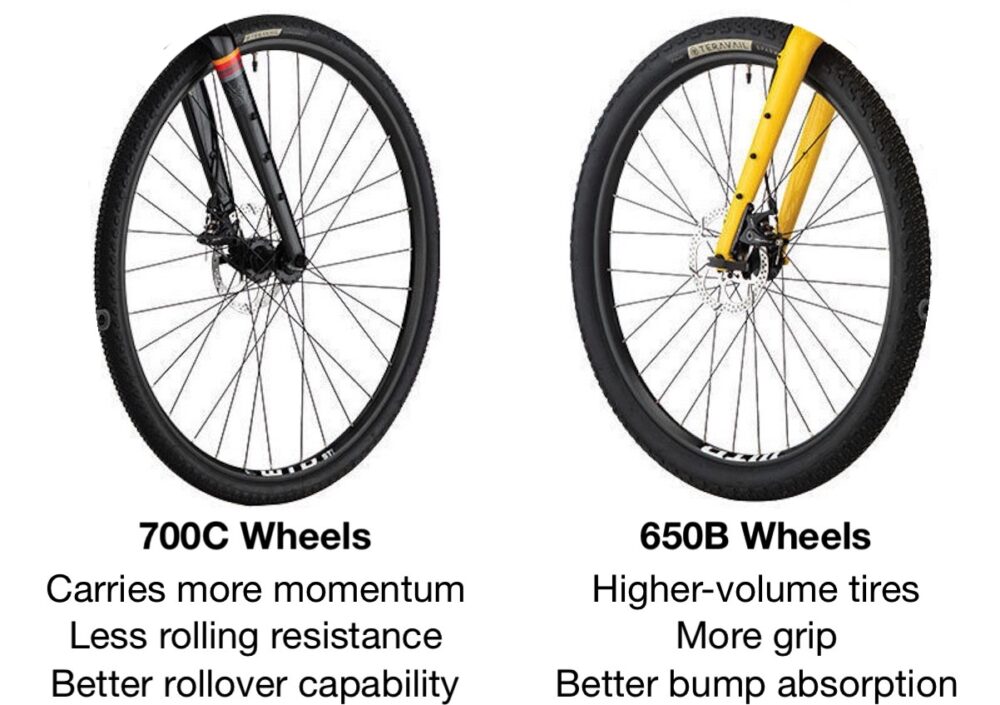Table of Contents
The Short Version
- Best Budget Gravel Bike Overall: Salsa Journeyer Advent
- Best Gravel Bike With Modern Features: Polygon Tambora G4
- Best Steel Gravel Bike: State 4130 All-Road
- Best For Rough Roads: Poseidon Redwood
- Best For Road Biking: Diamondback Haanjo 2
- Best Price to Weight: Poseidon X Ambition
- Best Classic Design: Marin Nicasio
The Long Version
Finding the best budget gravel bikes under $1,000 can be a daunting task, especially if this is your first bike purchase.
The good news is all of the gravel bikes on this list have been selected through our objective, data-driven rankings, which have been optimized based on our years working in the bike industry.
We have combed through hundreds of gravel bikes to find the best handling models, with broad size ranges, great features, adequate tire widths, suitable gear ratios, and all in the lightest possible package.
All you have to do is decide on the features that best suit your needs.
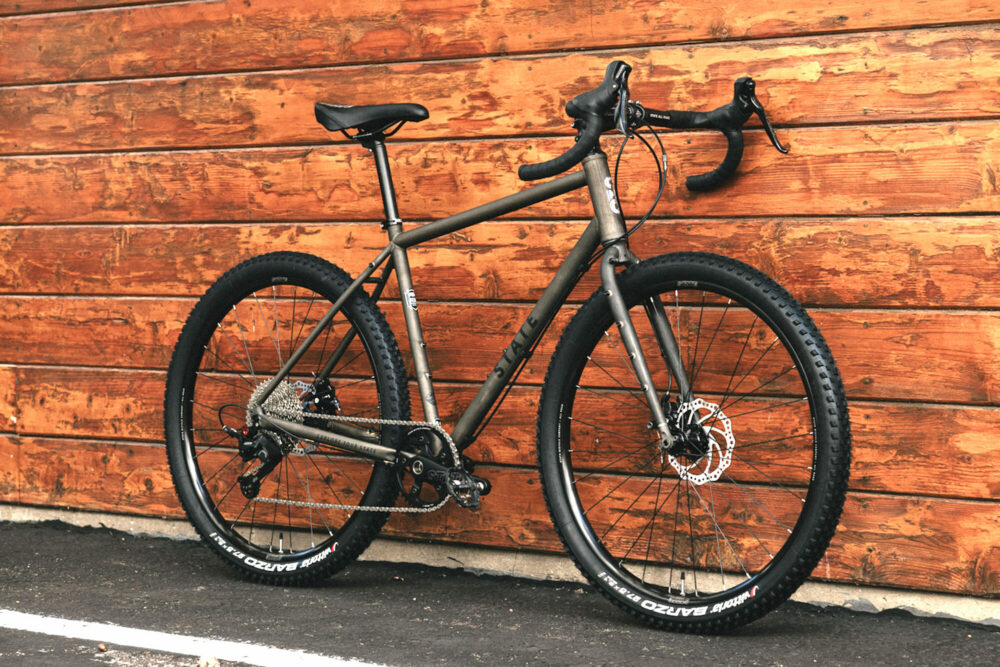
We’ve made this buyer’s guide your one-stop shop for finding the best budget gravel bike.
Accompanying the bike descriptions and score sheets are sizing charts that will help you pick the right size. We have even placed direct links to shops where you can buy these bikes, and have listed the shipping cost.
We have intentionally picked bikes that can be easily obtained in the USA (that’s most of you) and can be shipped directly to your door.
The author of this website has worked in the bike industry for over 20 years and has traveled the world by bicycle for over a decade. He has written multiple bicycle buyer’s guides that round up the best bikepacking and touring bikes.
All of this experience means that you can’t go wrong with any bike featured here.
Note: We may earn a commission when you purchase a bike through our links. This directly supports CYCLINGABOUT.com and allows us to continue providing high-quality cycling information to you.
Need To Know What To Look Out For?
To learn about the characteristics of a gravel bike and for full details of our scoring system, please check out the buying advice at the bottom of the article.
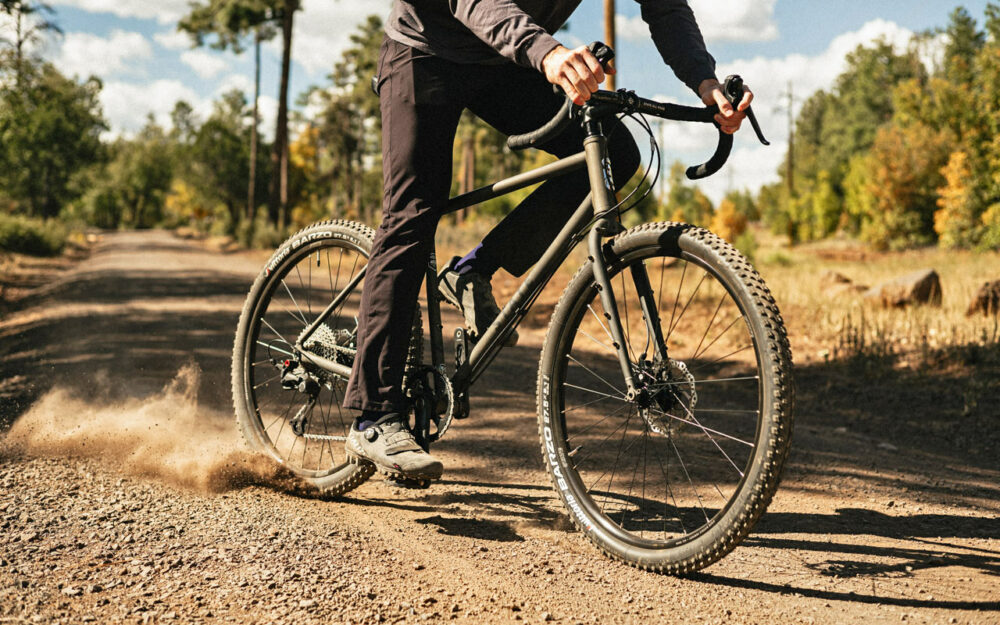
The Best Budget Gravel Bikes in 2024
Salsa Journeyer Advent – 19/20
The Best Budget Gravel Bike Overall
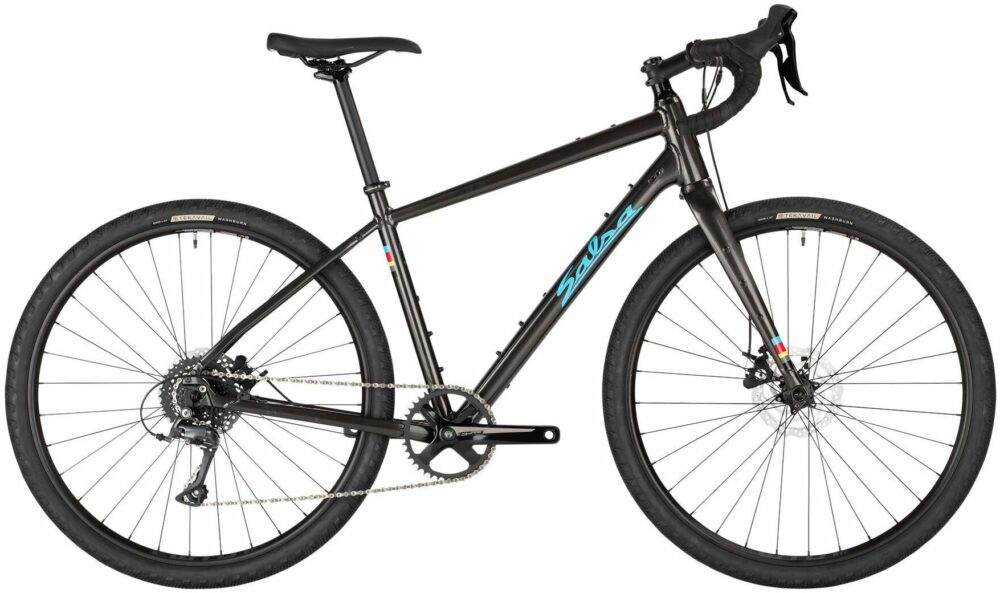
REASONS TO BUY
1. Excellent frame geometry and details
2. Choose 650B or 700C wheels
3. Fits riders from 4ft8 to 6ft5
REASONS NOT TO BUY
1. The gearing isn’t as low as we’d like
Salsa has put a huge amount of research and development into its Journeyer budget gravel bike range. The attention to detail shines through in the bike’s overall design – it offers a choice of wheel sizes, exceptional tire clearance, stable steering, mounts for different luggage setups, ample bottle cage mounts, fender compatibility, and size-proportionate handlebar widths.
The Journeyer is just 26lb (11.8kg) thanks to its lightweight aluminum frame and fork. It features a reliable microSHIFT 1×9 drivetrain and can fit wide 650B x 2.3” tires (or 700C x 2.2”) for rough dirt roads. The bike has a particularly low standover height so it’s great for riders down to 4ft8 (142cm) who are looking for a perfectly fitting bike.
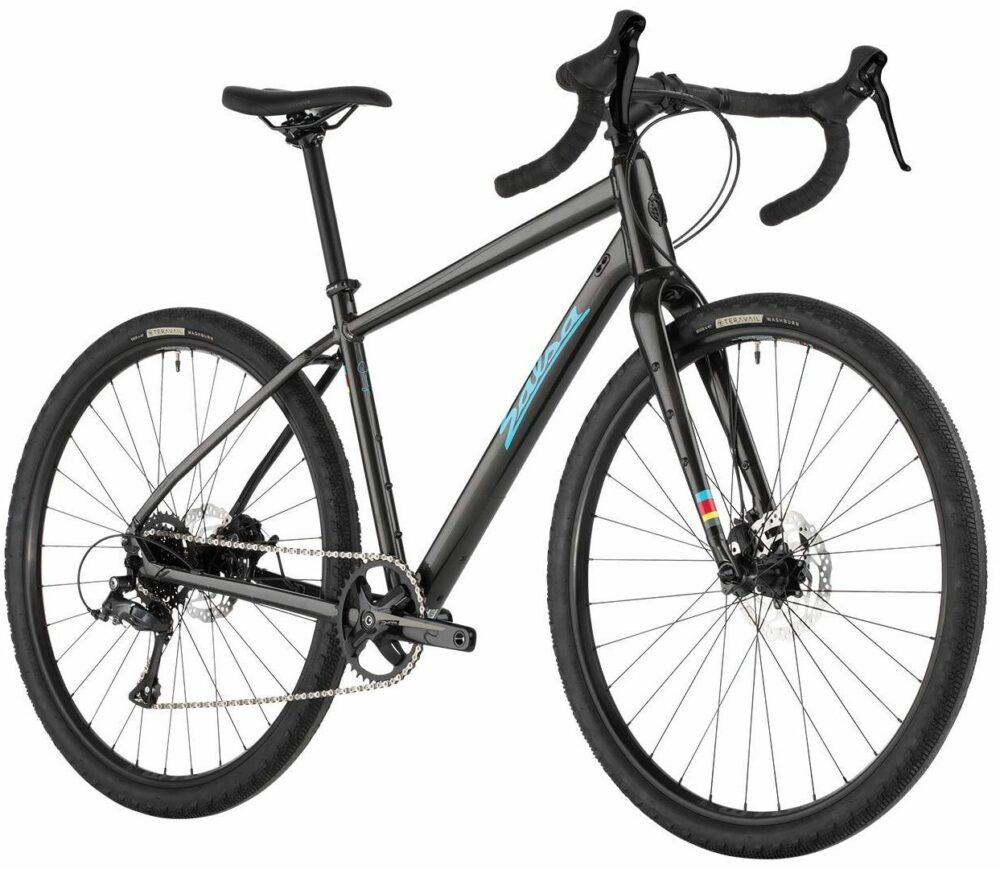
The only thing that kept the Journeyer from achieving a perfect score in our rating is the climbing gear that’s a bit high. If you live in a very hilly area, you might find yourself wanting an even lower gear (which is possible with a new front chain ring). That said, the standard gear ratio should be plenty low for most people.
We recommend smaller 650B wheels if you’re primarily cycling on dirt roads, and 700C wheels if you spend most of your time on pavement.
Determine your Salsa Journeyer frame size in the sizing recommendations.
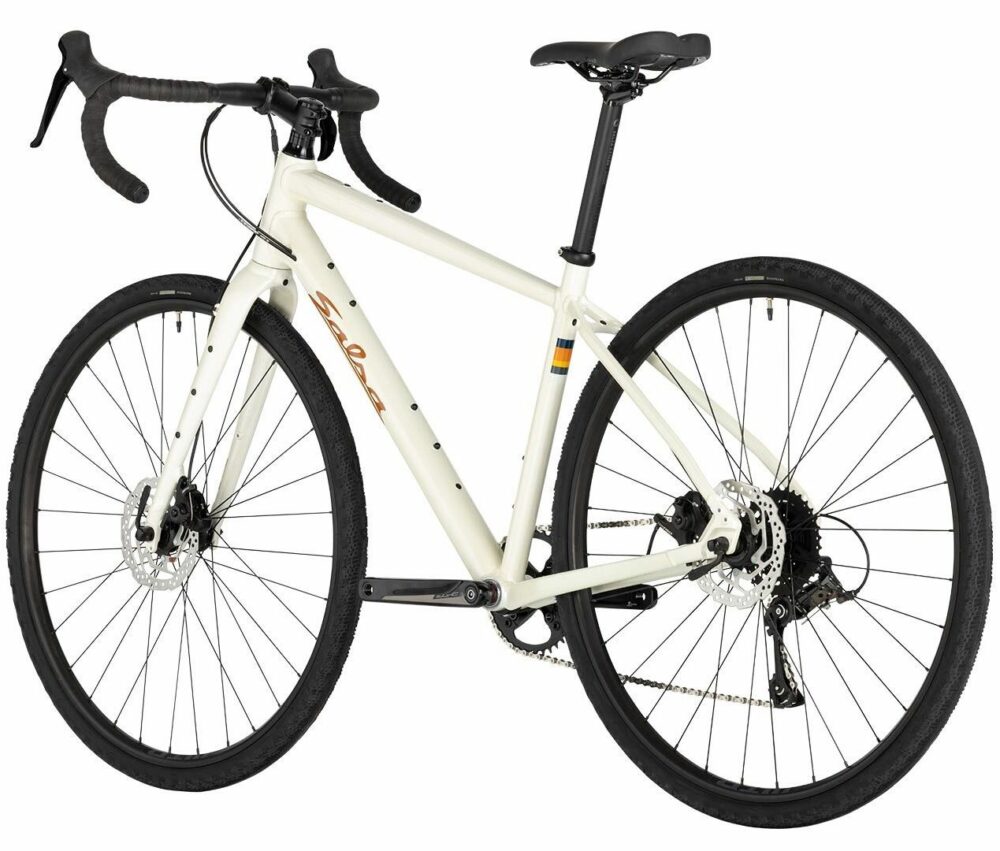
| Characteristic | Numerical Data | Score | |
| Steering Stability | Stable | 77mm Trail | 3/3 |
| Low Climbing Gear | Moderately Low | 26 Gear Inches | 2/3 |
| High-Speed Gear | High | 100 Gear Inches | 3/3 |
| Maximum Tyre Width | Very Wide | 2.3″ (58mm) | 3/3 |
| Tubeless Compatibility | Tubeless Compatible | – | 3/3 |
| Value For Money | Great | $999 | 3/3 |
| Weight Category | Lightest | 11.8kg (24.9lb) | 3/3 |
| Riding Position | Normal/Sporty | 1.50 | – |
| TOTAL SCORE | 19/20 | ||
| Salsa Journeyer with 650B Wheels | Salsa Journeyer with 700C Wheels | Shipping Cost | |
| See Price | See Price | $150 | |
| See Price | See Price | $75 | |
| See Price | See Price | $100 | |
| See Price | See Price | $85 |
Polygon Tambora G4 – 18/20
The Best Budget Gravel Bike With Modern Features
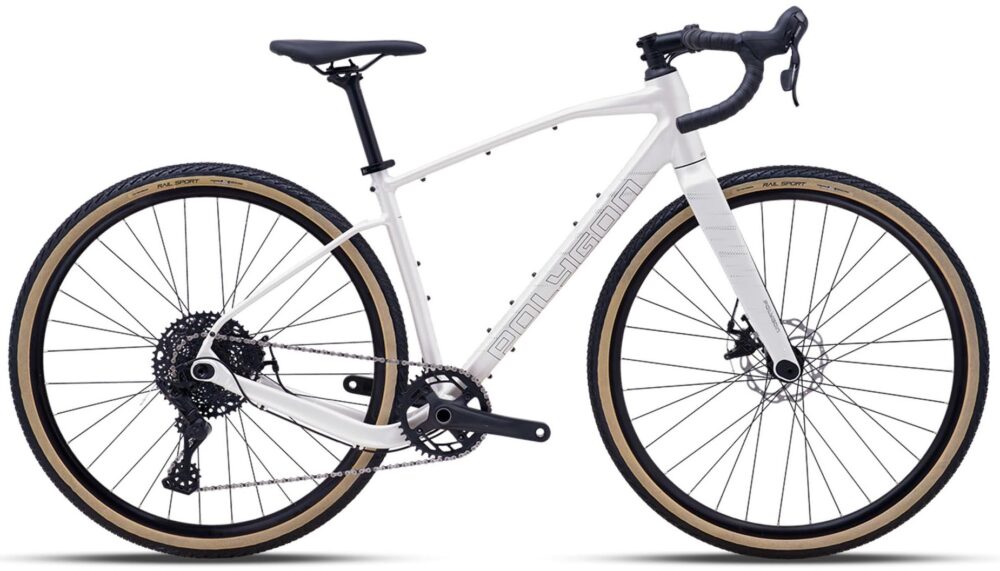
REASONS TO BUY
1. Upright/comfortable ride position
2. Thru-axles, tubeless, carbon fork
3. Great low climbing gear
REASONS NOT TO BUY
1. The cables are harder to maintain
2. The steering is quicker than most
The Tambora is a thoroughly modern bikepacking gravel bike with features usually found on more expensive bikes. It employs a uniquely shaped aluminum frame with an array of mounts for racks, fenders, water bottles, pumps, and frame packs. There’s a carbon fiber fork up front to add comfort, and the drivetrain is a solid 1×10 model from microSHIFT.
This bike has a flip-chip system at both the front and rear axles, which allows you to change the handling characteristics of the bike. By flipping the eccentric metal chips, you can make the bike handle slow and stable for gravel roads, or fast and responsive for paved roads.
This virtually makes the Tambora a two-in-one bike!
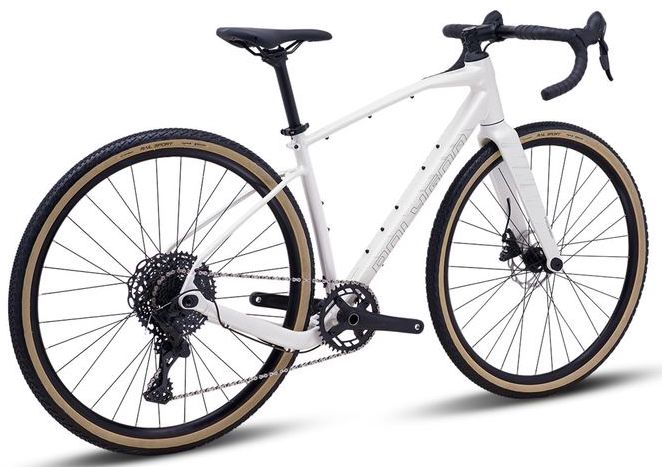
The Tambora has an upright riding position and notably low climbing gears. This bike will be great for riding up steeper hills – especially if you’re planning on carrying some luggage.
Although it does look nice, a downside to the Tambora G4 is the cable routing for the brakes and rear derailleur. They need to go through the headset bearings, which makes fitting new cables a more laborious job than on other bikes. The steering speed is also a bit quicker/twitchier than we’d like to see, although it’s not unreasonable.
Determine your Polygon Tambora frame size in sizing recommendations.
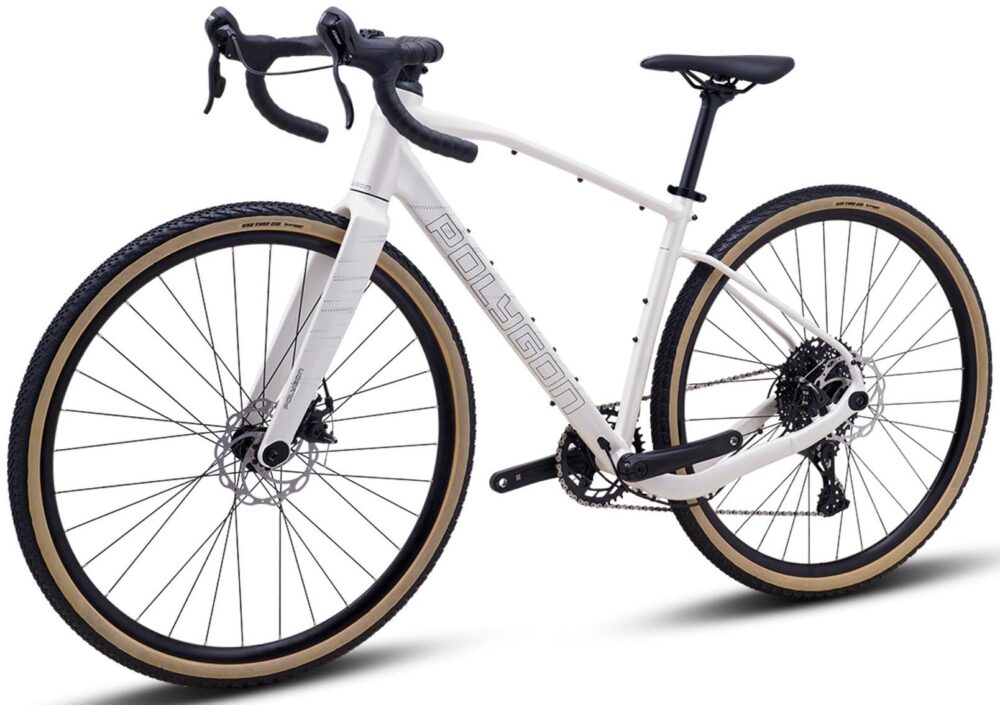
| Characteristic | Numerical Data | Score | |
| Steering Speed | Somewhat Stable | 66mm Trail | 2/3 |
| Low Climbing Gear | Very Low | 23 Gear Inches | 3/3 |
| High-Speed Gear | High | 101 Gear Inches | 2/2 |
| Max Tyre | Somewhat Wide | 45mm | 2/3 |
| Tubeless | Tubeless Compatible | – | 3/3 |
| Value For Money | Great | $899 | 3/3 |
| Weight Category | Below Average | 11.8kg (24.9lb) | 3/3 |
| Riding Position | Upright/Relaxed | 1.56 | – |
| TOTAL SCORE | 18/20 | ||
| Polygon Tambora G4 | Shipping Cost | Pick-Up | |
| See Price | $79 | No |
State 4130 All Road – 17/20
The Best Budget Gravel Bike With A Steel Frame

REASONS TO BUY
1. Upright riding position
2. Choose 650B or 700C wheels
3. Lots of customization options
REASONS NOT TO BUY
1. The low gear is a touch high
2. The steering is quicker than most
3. Limited frame sizes offered (4)
The State 4130 All Road is a steel-framed gravel bike ready for fun. It has ample tire clearance and lots of bag/rack mounts making it ready for off-road adventures. The notably upright riding position will allow you to ride comfortably all day should you put the bikepacking mounts to good use.
The 4130 comes with a 1×11-speed drivetrain, tubeless compatible wheels, generous 2.1” tire clearance, and reliable mechanical disc brakes. State also has a plethora of budget-friendly upgrades to make this your dream bike (brakes, forks, gears, wheels) although those will put you over $1,000.
In addition, this bike is usually available in several fun paint designs.

The State lost points when it came to steering speed; it’s a bit quicker than other bikes here, making it feel a bit twitchy at high speed. The climbing gear is also higher than we’d like to see, however, it will be great for most terrain you encounter.
We recommend choosing smaller 650B wheels if you’re primarily cycling on dirt roads, and 700C wheels if you spend most of your time on pavement.
Determine your State 4130 All Road frame size in sizing recommendations.

| Characteristic | Numerical Data | Score | |
| Steering Speed | Somewhat Stable | 64mm Trail | 2/3 |
| Low Climbing Gear | Somewhat Low | 27 Gear Inches | 2/3 |
| High-Speed Gear | High | 104 Gear Inches | 2/2 |
| Max Tyre | Wide | 53mm (2.1″) | 3/3 |
| Tubeless | Tubeless Compatible | – | 3/3 |
| Value For Money | Great | $899 | 3/3 |
| Weight Category | Average | 12.4kg (27.3lb) | 2/3 |
| Riding Position | Upright/Relaxed | 1.59 | – |
| TOTAL SCORE | 17/20 | ||
| State 4130 Black | State 4130 Copper | State 4130 Raw | |
$100 Shipping Cost | See Price | See Price | See Price |
$45 Shipping Cost | See Price | See Price | See Price |
Poseidon Redwood – 17/20
The Best Budget Gravel Bike For Rough Roads
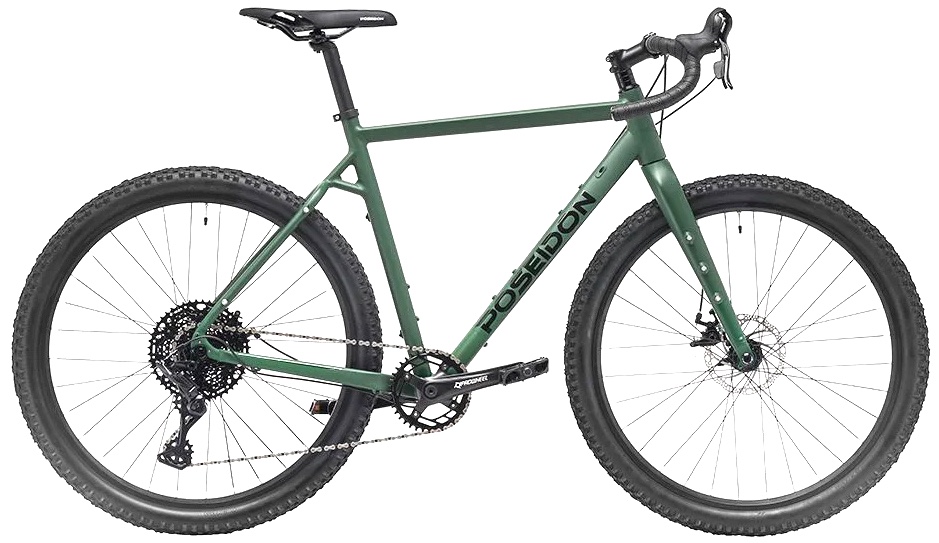
REASONS TO BUY
1. Excellent tire clearance
2. Thru-axles and tubeless
3. Multiple color options!
REASONS NOT TO BUY
1. Heavier than most gravel bikes
2. Large-diameter seatpost is less comfy
3. Not very upright in XL and XXL sizes
The Redwood shines though as Poseidon’s proper bikepacking gravel bike, that’s ready to take on any adventure. It employs a tough aluminum frame and fork with plenty of rack and accessory mounts. The drivetrain is a steadfast 1×10 model from microSHIFT.
The number one reason to choose this bike is the strong wheels and wide tires. The Redwood comes standard with 2.35” wide tires but it can squeeze in 2.6” tires if you need! The 650B wheels are connected with stiff thru-axles, and the rims are tubeless compatible.
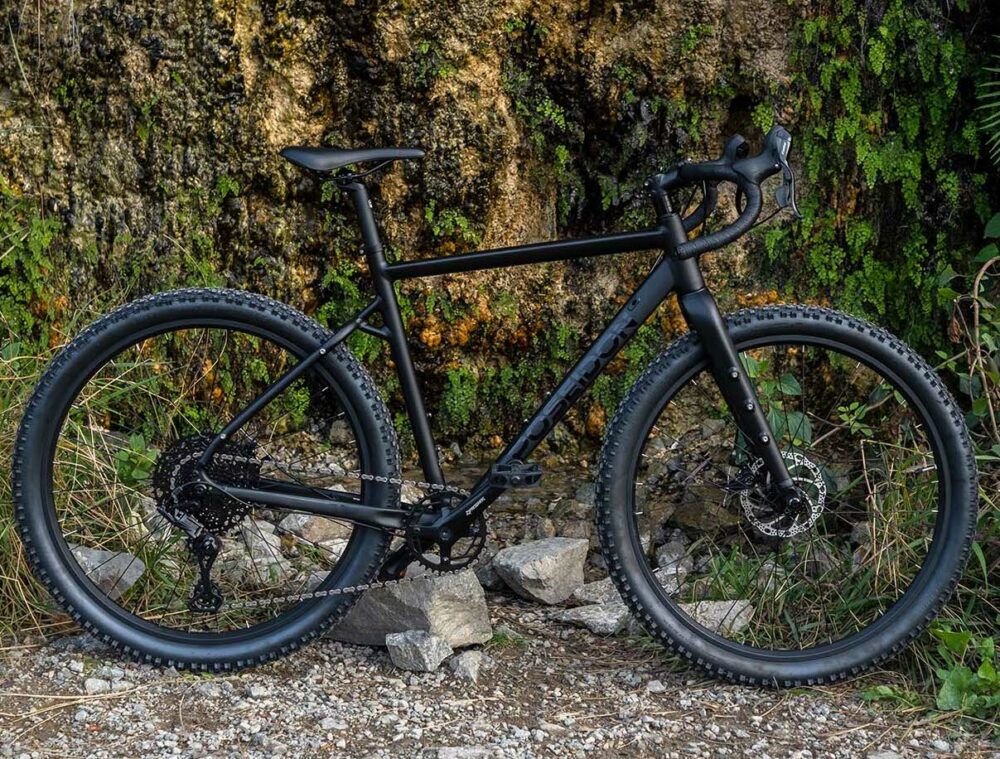
The Redwood also has notably low climbing gears for a gravel bike, which is great for riding up steeper hills, especially with a bikepacking load.
While the bike is adventure-ready, it does have a few drawbacks.
It’s heavier than the rest at 29 lbs (13.15 kg). It also has a large-diameter alloy seatpost that rides very firmly (although the wide tires should regain most of that comfort). Lastly, the XL and XXL frames are not very tall at the front, resulting in a lower handlebar than similarly sized gravel bikes – tall riders take note.
Determine your Poseidon Redwood frame size in sizing recommendations.
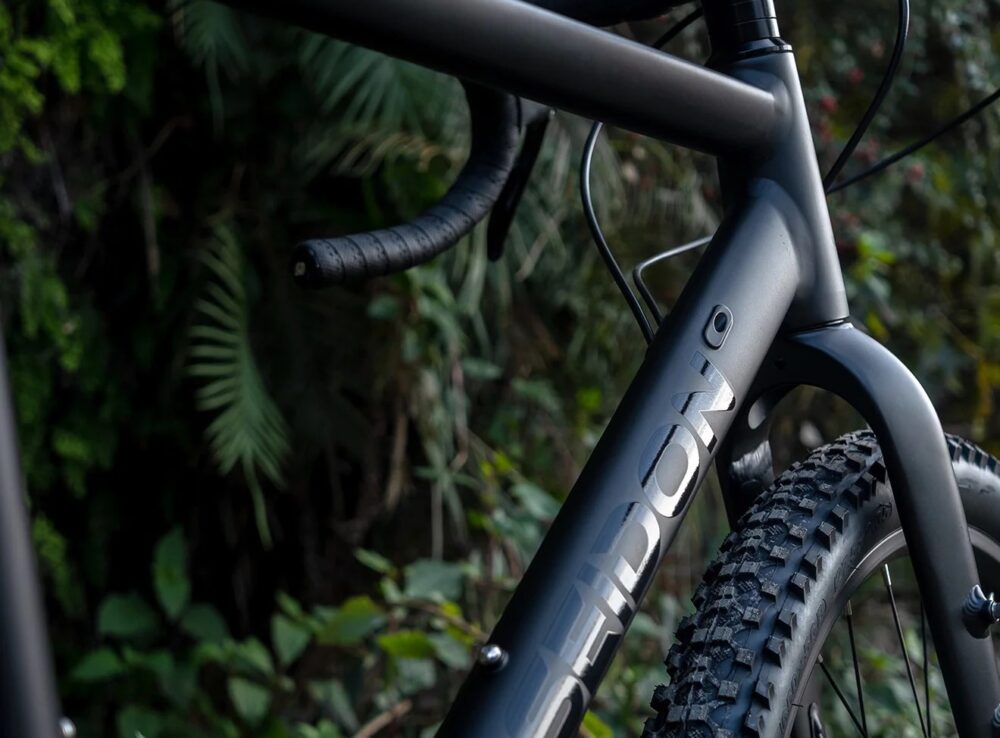
| Characteristic | Numerical Data | Score | |
| Steering Speed | Stable | 70mm Trail | 3/3 |
| Low Climbing Gear | Very Low | 22 Gear Inches | 3/3 |
| High-Speed Gear | Moderately High | 96 Gear Inches | 1/2 |
| Max Tyre | Very Wide | 60mm (2.4″) | 3/3 |
| Tubeless | Tubeless Compatible | – | 3/3 |
| Value For Money | Great | $999 | 3/3 |
| Weight Category | Above Average | 13.2kg (29.1lb) | 1/3 |
| Riding Position | Normal/Sporty | 1.49 | – |
| TOTAL SCORE | 17/20 | ||
| Poseidon Redwood | Shipping Cost | Pick-Up | |
| See Price | Free | Free |
Diamondback Haanjo 2 – 17/20
The Best Budget Gravel Bike For Pavement
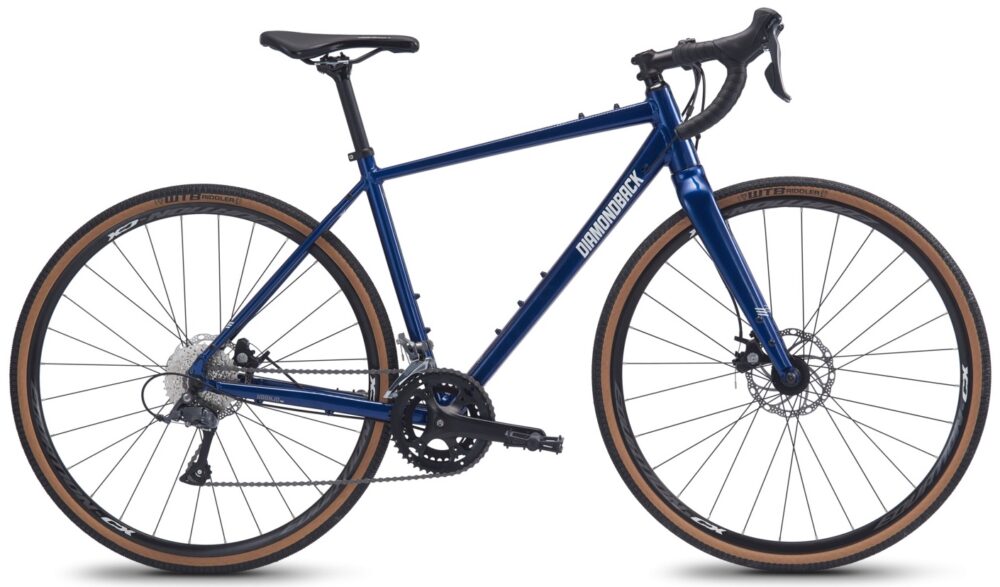
REASONS TO BUY
1. Lightweight and sporty geometry
2. Great gear ratios for the road
3. Tubeless ready
REASONS NOT TO BUY
1. Climbing gear is not very low
2. Max tire width narrower than some
When you hear of Diamondback bikes you might think of budget bikes at big box stores. Nowadays, they sell their high-quality bikes at budget prices direct-to-consumer, and they feature lots of thoughtful details.
The Haanjo is an all-purpose aluminum gravel bike with a modern road bike aesthetic. It weighs in at 26 lbs (11.79 kg). The bike employs the Shimano Claris 2×8 drivetrain and mechanical disc brakes.
The 2X drivetrain is perfect if you envision riding on a lot of paved roads, as it has smaller ‘steps’ when you change gears, and a great high-speed gear for long descents. That said, you might find yourself needing a lower climbing gear if you plan on riding in particularly hilly areas.

The Haanjo also features several smart component choices, such as size-specific handlebar widths. Depending on the bike size, the handlebars range from 38 to 46 cm wide. This means the shortest riders will have handlebars 8 cm narrower than the tallest riders, which better suits their body proportions. This is a notable feature as other bikes save money by ordering a one-size-fits-all handlebar.
You also receive a free toolkit with purchase, and Diamondback has a 30-day no-hassle return policy.
Determine your Diamondback Haanjo frame size in sizing recommendations.

| Characteristic | Numerical Data | Score | |
| Steering Speed | Stable | 72mm Trail | 3/3 |
| Low Climbing Gear | Not Very Low | 29 Gear Inches | 1/3 |
| High-Speed Gear | Very High | 115 Gear Inches | 2/2 |
| Max Tyre | Somewhat Wide | 42mm (1.7″) | 2/3 |
| Tubeless | Tubeless Compatible | – | 3/3 |
| Value For Money | Great | $999 | 3/3 |
| Weight Category | Lightest | 11.8kg (29.1lb) | 3/3 |
| Riding Position | Normal/Sporty | 1.50 | – |
| TOTAL SCORE | 17/20 | ||
| Diamondback Haanjo 2 | Shipping Cost | Store Pick-Up | |
| See Price | $85 | Free |
Poseidon X Ambition – 15/20
The Best Budget Gravel Bike For Price-To-Weight

REASONS TO BUY
1. Notably upright ride position
2. Low climbing gear
3. Lightest gravel bike under $1000
REASONS NOT TO BUY
1. Narrow maximum tire width
2. Not tubeless compatible
The Poseidon X Ambition is the speedy sibling of the Redwood. Every part of the X Ambition has been built for riding fast – it features 700C wheels that carry speed well, and a full carbon fork that saves about 1 lb (450 grams) compared to an aluminum or steel fork.
Poseidon didn’t just have speed in mind for the X Ambition though. It features an excellent low climbing gear ratio for steep hills and a notably upright riding position too.

This aluminum framed bike comes in at a lightweight 25 lbs. (11.34 kg). It uses the same microSHIFT 1×10 drivetrain as the Redwood and mechanical disc brakes finish off a great bike.
A downside is that the maximum tire size is fairly narrow at 42mm, however, if you’re aiming for speed and only need the bike for light off-road riding – that is plenty of clearance. It’s also worth noting the standard wheels are not tubeless compatible (but a wheel upgrade kit is available for a few hundred dollars extra).
Determine your Poseidon X frame size in sizing recommendations.

| Characteristic | Numerical Data | Score | |
| Steering Speed | Stable | 73mm Trail | 3/3 |
| Low Climbing Gear | Very Low | 22 Gear Inches | 3/3 |
| High-Speed Gear | Moderately High | 94 Gear Inches | 1/2 |
| Max Tyre | Somewhat Wide | 42mm (1.7″) | 2/3 |
| Tubeless | Not Tubeless Ready | – | 0/3 |
| Value For Money | Great | $899 | 3/3 |
| Weight Category | Lightest | 11.3kg (25.0lb) | 3/3 |
| Riding Position | Upright/Relaxed | 1.57 | – |
| TOTAL SCORE | 15/20 | ||
| Poseidon X Ambition | Shipping Cost | Pick-Up (CA) | |
| See Price | Free | Free |
Marin Nicasio – 9/20
The Best Budget Gravel Bike With A Classic Design

REASONS TO BUY
1. Great looking steel frame and fork
2. 2X drivetrain for pavement
3. Two color choices
REASONS NOT TO BUY
1. Narrower maximum tire width
2. Not tubeless compatible
The Nicasio is a steel bike with a classic look but modern features such as mechanical disc brakes and internal cable routing.
This bike has a geometry that blends on-road handling while providing extra stability for off-road use. Its upright riding position, low standover height, and steel comfort make it a top choice for all riders.

The Nicasio is available in two great colors and has plenty of mounting points for any adventure that you have planned. The Shimano Claris 2×8 drivetrain is a bit more suited to flatter, paved roads as it has high-speed gears for descending. The bike is a bit heavier than most at 27.62 lbs (12.53 kg) but it’s not at all unreasonable.
This bike has the narrowest tire clearance of all of the gravel bikes on this list at 700C x 40mm. This is usually enough for gravel riding but could be a bit narrow if you plan on riding in muddy or sandy conditions.
Determine your Marin Nicasio frame size in sizing recommendations.

| Characteristic | Numerical Data | Score | |
| Steering Speed | Somewhat Stable | 60mm Trail | 1/3 |
| Low Climbing Gear | Not Very Low | 29 Gear Inches | 1/3 |
| High-Speed Gear | Very High | 125 Gear Inches | 2/2 |
| Max Tyre | Somewhat Wide | 40mm (1.6″) | 1/3 |
| Tubeless | Not Tubeless Ready | – | 0/3 |
| Value For Money | Great | $899 | 3/3 |
| Weight Category | Above Average | 13.0kg (28.7lb) | 1/3 |
| Riding Position | Normal/Sporty | 1.53 | – |
| TOTAL SCORE | 9/20 | ||
| Marin Nicasio | Shipping Cost | Pick-Up | |
| See Price | $85 | Free | |
| See Price | – | Free |
Budget Gravel Bike Buying Advice
Frame Material

Aluminum – This is the most common frame and fork material in this price range. Aluminum provides the best balance between frame stiffness, lightweight performance, and cost-effectiveness.
Steel – People who ride steel bikes are often fanatics about them. They love the side-to-side flex that a steel frame offers, as well as the ability to easily repair the frame, should something break. The downside to this material is that it’s heavier than aluminum, usually by 2 or 3 pounds (1-1.5 kg).
Carbon Fiber – While there aren’t any carbon fiber bikes on this list, a few bikes do feature a carbon fork. Carbon forks shave off a pound of weight and can be more forgiving over bumps. A carbon fork is a great upgrade for those who are looking to squeeze out the most performance.
Drivetrain Type

1X – A single chainring in the front eliminates the front derailleur. These drivetrains are paired with a wide-range cassette at the rear so you can still maintain a broad gear range. The simplicity of a 1X system is appealing to riders who want ease of use, and less mechanical hassle.
2X – A double chainring drivetrain offers a broader range of gear ratios by featuring two front chainrings. This allows for smaller differences between gears on the rear cassette, providing a more consistent cadence (pedalling speed in RPM) across a wider range of speeds, gradients, and terrains. A 2X setup is a great choice for people who will do a lot of paved road riding.
Wheel Size
The choice of wheel size ultimately comes down to personal preference, some companies such as State Bicycle offer a second wheelset for an additional fee, and other companies like Salsa offer the same model in both wheel sizes.
700C (29″) – 700C has been the standard road bike wheel size for decades. Its large diameter allows for a greater rollover capability, so 700C can clear obstacles easily while carrying more momentum. This makes them ideal for riders who prefer to ride faster with greater efficiency.
650B (27.5”) – By reducing the rim size, you can fit higher-volume tires on the same gravel bike frame. Wider tires provide more grip and reduce body fatigue on rough terrain. This wheel size is ideal for those who want to prioritize bike control and ride comfort.
Handlebar Type

There are advantages and disadvantages to drop bars and flat bars, and your choice ultimately boils down to how you want to use your bike. You can read our full pros/cons article about handlebar type HERE.
Drop Bars (Curly Ones) – These bars offer a more aerodynamic riding position that is ideal for long days on the bike. and more hand positions than their flat bar counterparts. Due to their narrower width, they are often better for squeezing between cars and urban obstacles.
Flat Bars (Not Curly Ones) – Flat bars offer extra steering leverage for better bike control, and the ride position they put you in is usually a bit more upright. This makes them a great option for beginners. Our list of the best flat bar gravel bikes (under $1000) is coming soon.
The CYCLINGABOUT Scoring System
Steering Speed
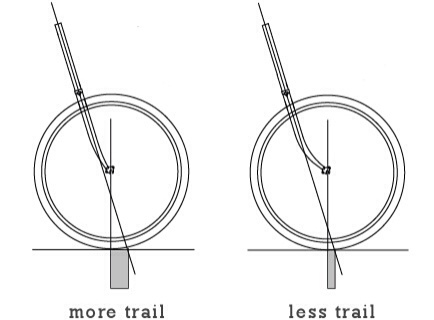
We assign:
3 points to a bike with a trail of 68mm or more
2 points to a bike with a trail between 61 and 68mm
1 point to a bike with a trail 60mm or less.
Steering speed is an important part of our rankings. We use the ‘trail’ measurement, which gives us the best approximation of how a bike’s steering will feel to you the rider. This article on Bike Insights gives a great in-depth analysis of what constitutes trail.
Generally, mountain bikes have the highest trail figure (90-130mm), resulting in a slow steering feel. This keeps them extremely stable at high speeds, especially when combined with a wide flat handlebar and short stem.
On the opposite end, road bikes generally have the lowest trail figure (50-70mm), resulting in a quick steering feel that best suits the characteristics of a narrow drop bar and longer stem.
Low Climbing Gear

We assign:
3 points to a bike with a climbing gear of below 24 gear inches
2 points to a bike with a climbing gear between 24 and 28 gear inches
1 point to a bike with a climbing gear above 28 gear inches
We measure the lowest and highest gears on a gravel bike using “gear inches”. They are calculated using the diameter of your wheel, multiplied by the front sprocket, and divided by your rear cog. That gives us a convenient two or three-digit number to compare bikes that use different wheel sizes and tire widths.
The good news is that you don’t have to calculate the gear inches manually, websites like Gear-Calculator work them out for you.
On a gravel bike, the ideal climbing gear is generally 24 gear inches or below as this gear allows you to pedal comfortably up a steep hill at 7kph/4mph. 24 to 28 gear inches is generally acceptable on moderately steep terrain, and 28 or above is better suited to milder gradients.
High-Speed Gear
We assign:
2 points to a bike with a high-speed gear above 100 gear inches
1 points to a bike with a high-speed gear below 100 gear inches
At the other end of the scale, the ideal high gear is somewhere over 100 gear inches. This will give you enough gears to pedal down a hill at 48kph/30mph. Stepping up to 125 gear inches for your high-speed gear, and you can still pedal at 60kph/37mph.
Maximum Tire Size

We assign:
3 points to a maximum tire width of 47mm or wider
2 points to a max tire width of 42 to 47mm
1 point to a max tire width of 42mm or narrower
The maximum tire width is determined by frame and fork clearance. Bikepackers typically choose the widest tire available, as the wider the tire the more varied the terrain you can ride. This is why bikes with a larger tire clearance received higher scores in our rankings.
Wider tires have a larger contact patch with the ground. This gives you more grip as you navigate challenging terrain. A wider tire can also absorb vibrations and impacts more effectively, providing a smoother overall ride.
The good news is that wider tires won’t slow you down much because it’s the tire’s rubber compound that primarily (~80%) determines rolling resistance. In fact, some wide/nobby mountain bike tires roll much faster than slick road bike tires!
Tubeless Compatibility

We assign:
3 points to a bike that has tubeless compatible wheels
0 points to a bike that has tube-only wheels
Tubeless – A tubeless setup has a reduced risk of flats due to the latex-based sealant inside. The sealant is to self-seal small punctures caused by thorns or debris.
A tubeless setup also allows riders to run lower tire pressure for a more cushioned ride without the risk of pinch flats. To run a tubeless setup, both the rim and tires need to be tubeless compatible. The initial setup requires a bit of familiarity with putting sealant into tires and seating the tire on the rim.
The ranking system we use places a lot of emphasis on bikes with tubeless compatibility, as it is such great convenience.
Tubes – Tires with tubes are easier to install and more straightforward for most users. It’s worth noting that all tubeless wheels can fit tubes.
Value For Money
We assign:
3 points to a very good value bike
2 points to a good value bike
1 point to a bike of ok value-for-money
Admittedly, this metric is rather subjective, however, we have a good sense of the quality of the frame, fork, and components and whether they match the asking price of the bike.
Weight
We assign:
3 points to a bike under 12kg (26.5lb)
2 points for a bike between 12-13kg (26.5-28.7lb)
1 point for a bike over 13kg and over (28.7lb)
Weight is one of the easiest things to measure on a bicycle, so it is often the emphasis. However, it’s our opinion that bike weight matters much less than you think. This is because a 1kg (2.2lbs) heavier bike usually only results in a one or two-minute time penalty over a 100km (62mi) hilly ride.
Nonetheless, a lightweight gravel bike often uses higher-quality components and materials, so this is still an important metric.
Riding Position
We use the average stack-to-reach ratio of all frame sizes to determine whether a bike has a ‘sporty’ or ‘relaxed’ riding position. This metric gives us an idea of how high the handlebar is relative to your saddle height.
Normal/Sporty means the bike’s handlebar is a typical height compared to other gravel bikes. A bike is considered sporty when the average stack-to-reach ratio is under 1.55.
Upright/Relaxed means the bike’s handlebar is higher than average compared to other gravel bikes. A bike is considered ‘relaxed’ when the average stack-to-reach ratio is 1.55 or above.
It’s worth noting that you can turn a ‘sporty’ bike into a ‘relaxed’ bike by increasing a bike’s handlebar height using a riser stem or steerer tube extender. These products normally add 25 to 75mm (1-3″) of bar height.
Sizing Recommendations
Simply find your height and inseam on these charts to determine the size(s) that will fit you.
If you’re on the boundary between two sizes, those with a long inseam often prefer the taller handlebar height of the bigger frame size. Conversely, if you’d like a lower handlebar height for a performance-oriented riding position, simply choose the smaller size.
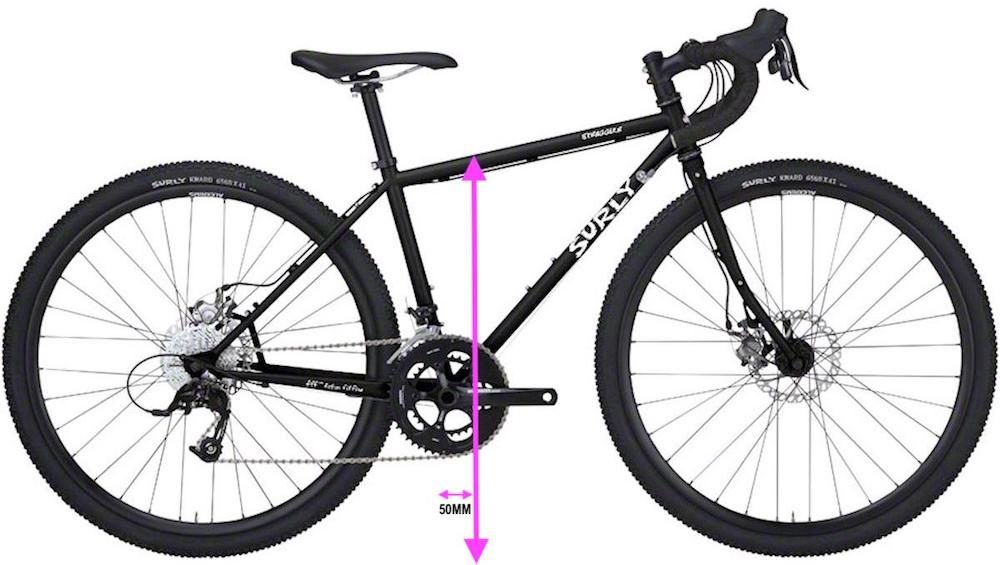
The frame standover is the measurement from the ground to the top tube (50mm/2.0″ in front of the bottom bracket). Ideally, this measurement is less than your inseam so that your crotch has clearance over the bike frame.
Salsa Journeyer Advent
What Salsa Journeyer Frame Size Should You Buy?
| Size | Rider Height | Inseam (in) | Rider Height | Inseam (mm) | Frame Standover |
| 49cm | 4’8″ to 5’0″ | 25.1 to 28.7″ | 142cm to 152cm | 638 to 728mm | 23.9″ (606mm) |
| 51cm | 4’11” to 5’3″ | 26.7 to 30.1″ | 150cm to 160cm | 678 to 766mm | 25.2″ (641mm) |
| 53cm | 5’2″ to 5’7″ | 28.1 to 31.9″ | 157cm to 170cm | 716 to 809mm | 26.6″ (677mm) |
| 55cm | 5’5″ to 5’10” | 29.9 to 33.4″ | 165cm to 178cm | 759 to 848mm | 28.0″ (713mm) |
| 57cm | 5’8″ to 6’1″ | 31.4 to 35.5″ | 173cm to 185cm | 798 to 903mm | 29.5″ (749mm) |
| 60cm | 6’0″ to 6’5″ | 33.5 to 38.4″ | 183cm to 196cm | 853 to 976mm | 30.3″ (769mm) |
| Salsa Journeyer with 650B Wheels | Salsa Journeyer with 700C Wheels | Shipping Cost | |
| See Price | See Price | $150 | |
| See Price | See Price | $75 | |
| See Price | See Price | $100 | |
| See Price | See Price | $85 |
Polygon Tambora G4
What Polygon Tambora Frame Size Should You Buy?
| Size | Rider Height | Inseam (in) | Rider Height | Inseam (mm) | Frame Standover |
| S | 5’1″ to 5’4″ | 26.7″ to 30.9″ | 150cm to 163cm | 678 to 784mm | 28.2″ (716mm) |
| M | 5’4″ to 5’9″ | 29.3″ to 32.9″ | 163cm to 175cm | 743 to 836mm | 29.7″ (755mm) |
| L | 5’9″ to 6’2″ | 31.9″ to 35.7″ | 175cm to 188cm | 811 to 906mm | 31.5″ (799mm) |
| XL | 6’2″ to 6’5″ | 34.7″ to 37.4″ | 188cm to 195cm | 881 to 951mm | 32.8″ (833mm) |
| Polygon Tambora G4 | Shipping Cost | Pick-Up | |
| See Price | $79 | No |
State 4130 All-Road
What State 4130 All Road Frame Size Should You Buy?
| Size | Rider Height | Inseam (in) | Rider Height | Inseam (mm) | Frame Standover |
| XS | 5’1″ to 5’6″ | 27.7 to 31.9″ | 155cm to 168cm | 704 to 809mm | 28.9″ (735mm) |
| S | 5’5″ to 5’10” | 29.9 to 33.9″ | 165cm to 178cm | 759 to 861mm | 30.0″ (764mm) |
| M | 5’9″ to 6’2″ | 31.9 to 36.1″ | 173cm to 188cm | 811 to 918mm | 31.1″ (790mm) |
| L | 6’1″ to 6’5″ | 34.1 to 38.4″ | 185cm to 196cm | 868 to 976mm | 32.2″ (819mm) |
| State 4130 All-Road Black | State 4130 All-Road Copper | Shipping Cost | |
| See Price | See Price | $100 | |
| See Price | See Price | $45 |
Poseidon Redwood
What Poseidon Redwood Frame Size Should You Buy?
| Size | Rider Height | Inseam (in) | Rider Height | Inseam (mm) | Frame Standover |
| XXS | 5’0″ to 5’3″ | 27.1 to 31.2″ | 152cm to 160cm | 690 to 793mm | 29.9″ (758mm) |
| XS | 5’4″ to 5’7″ | 29.2 to 32.9″ | 160cm to 170cm | 743 to 835mm | 30.6″ (775mm) |
| S | 5’7″ to 5’10” | 30.9 to 33.9″ | 170cm to 177cm | 785 to 861mm | 31.3″ (794mm) |
| M | 5’9″ to 6’0″ | 31.9 to 35.5″ | 175cm to 183cm | 811 to 903mm | 31.8″ (807mm) |
| L | 6’0″ to 6’3″ | 33.5 to 37.2″ | 183cm to 190cm | 853 to 945mm | 32.5″ (826mm) |
| XL | 6’3″ to 6’5″ | 35.2 to 38.4″ | 190cm to 196cm | 895 to 976mm | 33.2″ (842mm) |
| Poseidon Redwood | Shipping Cost | Pick-Up | |
| See Price | Free | Free |
Diamondback Haanjo 2
| Size | Rider Height | Inseam (in) | Rider Height | Inseam (mm) | Frame Standover |
| 47cm | 5’1″ to 5’4″ | 27.7 to 30.2″ | 155 to 163cm | 704 to 793mm | 27.0″ (680mm) |
| 50cm | 5’4″ to 5’8″ | 29.2 to 32.9″ | 163 to 173cm | 743 to 835mm | 28.9″ (735mm) |
| 53cm | 5’7″ to 5’10” | 30.9 to 33.9″ | 170 to 178cm | 785 to 861mm | 30.3″ (772mm) |
| 56cm | 5’10” to 6’1″ | 32.4 to 35.5″ | 178 to 185cm | 824 to 903mm | 31.5″ (800mm) |
| 59cm | 6’1″ to 6’4″ | 34.1 to 37.7″ | 185 to 193cm | 868 to 959mm | 32.6″ (828mm) |
| Diamondback Haanjo 2 | Shipping Cost | Store Pick-Up | |
| See Price | $85 | Free |
Poseidon X Ambition
What Poseidon X Ambition Frame Size Should You Buy?
| Size | Rider Height | Inseam (in) | Rider Height | Inseam (mm) | Frame Standover |
| S | 5’3″ to 5’6″ | 28.7 to 31.9″ | 160 to 168cm | 731 to 809mm | 30.5″ (775mm) |
| M | 5’5″ to 5’9″ | 29.9 to 33.4″ | 165 to 175cm | 759 to 848mm | 31.25″ (794mm) |
| L | 5’8″ to 6’0″ | 31.4 to 35.0″ | 173 to 180cm | 798 to 881mm | 32.0″ (813mm) |
| XL | 5’11” to 6’2″ | 33.0 to 34.6″ | 175 to 185cm | 840 to 920mm | 32.8″ (832mm) |
| XXL | 6’2″ to 6’6″ | 34.6 to 38.8″ | 185 to 198cm | 881 to 987mm | 33.8″ (857mm) |
| Poseidon Redwood | Shipping Cost | Pick-Up | |
| See Price | Free | Free |
Marin Nicasio
What Marin Nicasio Frame Size Should You Buy?
| Size | Rider Height | Inseam (in) | Rider Height | Inseam (mm) | Frame Standover |
| 47cm | 4’10” to 5’1″ | 26.2 to 29.1″ | 147 to 155cm | 670 to 740mm | 25.9″ (658mm) |
| 50cm | 5’0″ to 5’4″ | 27.1 to 30.7″ | 152 to 163cm | 690 to 781mm | 27.5″ (700mm) |
| 52cm | 5’3″ to 5’7″ | 28.7 to 32.4″ | 160 to 170cm | 731 to 822mm | 28.7″ (730mm) |
| 54cm | 5’6″ to 5’10” | 30.4 to 33.9″ | 167 to 178cm | 772 to 861mm | 29.8″ (758mm) |
| 56cm | 5’9″ to 6’1″ | 31.9 to 35.5″ | 175 to 185cm | 811 to 903mm | 30.5″ (777mm) |
| 58cm | 6’0″ to 6’3″ | 33.5 to 36.6″ | 183 to 191cm | 853 to 931mm | 31.3″ (796mm) |
| 60cm | 6’2″ to 6’5″ | 34.6 to 38.4″ | 188 to 196cm | 881 to 976mm | 31.9″ (812mm) |


